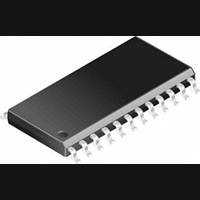CS5524-AS Cirrus Logic Inc, CS5524-AS Datasheet - Page 39

CS5524-AS
Manufacturer Part Number
CS5524-AS
Description
A/D Converter (A-D) IC
Manufacturer
Cirrus Logic Inc
Datasheet
1.CS5524-AS.pdf
(56 pages)
Specifications of CS5524-AS
Sample Rate
606SPS
Input Channels Per Adc
4
Mounting Type
Surface Mount
No. Of Channels
4
Power Rating
9mW
Peak Reflow Compatible (260 C)
No
Supply Voltage Max
5.25V
Lead Free Status / RoHS Status
Contains lead / RoHS non-compliant
Available stocks
Company
Part Number
Manufacturer
Quantity
Price
Part Number:
CS5524-ASZ
Manufacturer:
CIRRUS
Quantity:
20 000
SD0. After ‘11111111’ is provided, 24 additional
SCLKs are required to transfer the last 3 bytes of
conversion data before the serial port will return to
the command mode.
Example 3:
The configuration register has the following bits as
shown:
RC = X. The command issued is ‘1XXXX000’.
These settings instruct the converter to perform a
single conversion on six Setups once. The order in
which the channels are converted is 6, 1, 6, 2, 6, and
3. SDO falls after physical channel 3 is converted.
To read the 6 conversion results 8 SCLKs are re-
quired to clear the SD0 flag. Then 144 additional
SCLKs are required to read the conversion data
from the FIFO. Again, the order in which the data
is provided is the same as the order in which the
channels are converted. After the last 3 bytes of the
conversion data corresponding to physical channel
3 is read, the serial port automatically returns to the
command mode where it will remain until the next
valid command byte is received.
Example 4:
The configuration register has the following bits as
shown:
RC = 0.
‘1XXXX000’. These settings instruct the converter
to repeatedly perform multiple-setup conversions
using ten Setups. The order in which the channels
are converted is: 6, 1, 6, 2, 6, 3, 6, 4, 6, 5. SDO falls
after physical channel 5 is converted. To read the
10 conversion results 8 SCLKs with SDI = 0 are re-
quired to clear the SD0 flag. Then 240 more
SCLKs are required to read the conversion data
from the FIFO. The order in which the data is pro-
vided is the same as the order in which the channels
are converted. The first 3 bytes of data correspond
to the first Setup which in this example is physical
channel 6; the next 3 bytes of data correspond to the
second Setup which in this example is physical
channel 1; and, the last 3 bytes of data corresponds
DS317F2
DP3-DP0 = ‘1001’,
DP3-DP = ‘0101’,
The
command
MC = 1,
byte
MC = 1,
issued
LP = 0,
LP = 1,
is
to 10th Setup which here is physical channel 5.
Since the Setups are converted in the background,
while the data is being read, the user must finish
reading the conversion data FIFO before it is updat-
ed with new conversions. To exit this conversion
mode the user must provide ‘11111111’ to SDI
during the first 8 SCLKs. If a byte of 1’s is provid-
ed, the serial port returns to the command mode
only after the conversion data FIFO is emptied (in
this case 10 conversions are performed). Note that
in this example physical channel 6 is converted five
times. Each conversion could be with the same or
different filter rates depending on the setting of Set-
ups 1, 3, 5, 7 and 9. Note that there is only one off-
set and one gain register per physical channel.
Therefore, any physical channel can only be cali-
brated for the gain range selected during calibra-
tion. Specifying a different gain range in the Setup
other than the range that was calibrated will result
in a gain error.
Example 5:
The configuration register has the following bits as
shown: DP3-DP0 = ‘XXXX’, MC = X, LP = X,
RC = X. The command issued is ‘10101101’.
These settings instruct the converter to perform a
system offset calibration of the 6th Setup (which is
physical channel 3 in this example). During cali-
bration, the serial port remains in the command
mode. Once the calibration is completed, SDO
falls. To perform additional calibrations, more
commands have to be issued.
Notes: 1)The configuration register must be written before
3) When single-Setup conversions (MC = 0) are de-
2) The CSRs need to be written irrespective of single
conversion or multiple single conversion mode.
channel-setup registers (CSRs) because the depth
information contained in the configuration regis-
ter defines how many of the CSRs to use.
sired, the channel address is embedded in the
command byte. In the multiple-Setup conversion
mode (MC = 1), channels are selected in a pre-
programmed order based on information con-
tained in the CSRs and the depth bits (DP3-DP0)
CS5521/22/23/24/28
39

















